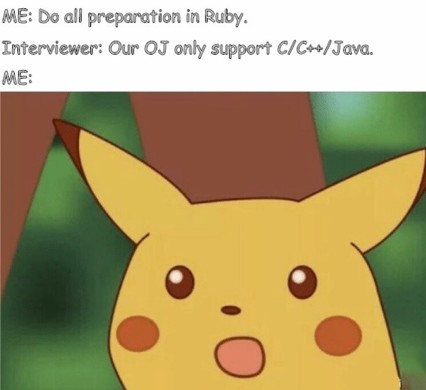Table of Contents
leetcode-ruby
What are those
These are my leetcode solutions along with some other stuff:
- Each id.problem_title.rb is a leetcode solution in ruby.
- other contains problems which are not on leetcode.
- data-structures contains the general data structures I use to solve problems. They are used throughout my solutions.
What you get
- Solutions have problem description with it so that you don’t need to visit leetcode. You can also use this repo with leetcode-cli. If you are using Emacs, you can use my plugin lain-leetcode.el.
- Well documented code, see 4.median-of-two-sorted-arrays.rb for an example.
- Some problems are difficult to understand if I just shove the optimal solution in your face, therefore I write my thought process and code evolving process, see 10.regular-expression-matching.rb for an example.
- Well written code, maybe? Coming from FP and OOP background, I tend to write concise function and class with clean API.
Ruby
Ruby, as Matz said, really is a programming language that makes my happy (with leetcode problems of course, being a dynamically typed language after all). But Ruby is not the language to solve intense problems on codeforces or spoj, you’ll get TLE most of the time. However I like to prototype using Ruby for its easy-to-write nature, then rewrite in C/C++.
Ruby arrays are dynamic, it’s kind of like C++’s std::vector or
Java’s ArrayList. Its shift (delete at beginning), unshift
(insert at beginning), push (insert at end) and pop (delete at
end) are amortized O(1) ops. With those amortized O(1) ops it can
simulate stack and queue:
Stack
stack = []
stack << 2 # push 2 => stack = [2]
stack << 3 # push 3 => stack = [2, 3]
stack.pop # pop 3 => stack = [2]Queue
queue = []
queue << 2 # push 2 => queue = [2]
queue << 3 # push 3 => queue = [2, 3]
queue.shift # pop 2 => queue = [3]Map
Maps in ruby are hashes:
map = {} # empty map
map = Hash.new(0) # or a map with a default value of 0
map[:a] = 1 # map = {a:1}
map[:b] = 2 # map = {a:1,b:2}Set
set = Set.new # empty set
set << 1 # set = #{1}
set << 2 # set = #{1,2}
set << 1 # set = #{1,2}Other Data Structures
Other data structures such as Priority Queue, Heap, BST, Ruby doesn’t
have them build-in, so I implement them when I need to, see
data-structures directory:
uniou-find.rbUnion Find (weighed quick-union with path compression).heap.rbMin Heap, Max Heap and Priority Queue.fenwick-tree.rb1d Fenwick Tree with range sum query.segment-tree.rb1d Segment Tree with various query examples.sparse-table.rb1d Sparse Table with range minimum/maximum query.treap.rbTreap (rotation based and merge/split based).
Memes
Other Useful Stuff
Algorithm
- E-Maxx Algorithms
- Algorithms WTF
- Algorithms Live!
- CS106B
- Codeforces Blogs
- Contest List
- Binary Search
- Dynamic Programming
System design
- Consistent Hashing
Other
- TODO Knight Tour
- Fair Work Load (Binary Search)
- TODO HashMap With Expiration Time


